
The Breunsdorf Story
An interesting story of how a lost apple variety was recovered and propagated.....
From my point of view it all began in 2005. This is how I described the 'Breunsdorfer' apple in my red-fleshed apple index:
......Variety from East Germany almost lost when the orchards containing it disappeared under opencast coal mines. A lady visiting the area took an apple home before the bulldozers moved in and planted the seeds. One seedling produced apples true to type. The lady contacted this website, offering scion wood, but I'd just run out of rootstocks, so I referred her a to a friend in Germany. The tree was re-grafted, and he now has several trees; others also exist. He sent me scions a year later, and I too have a few copies.
I wrote to the lady several years later, to ask how her own tree was doing; this is what she told me.......
............Thank you so much for contacting me. I am delighted that my Breunsdorf apple will live again. I grew her from a pip and she appeared to come true - same sort of tree, same bark, same dark red apple (although paler where sun doesn't get). It had the same dark red leaves fading to slightly greener with age, the same red wood, the same mahogany red pips and pink flesh. It tasted the same too, slightly tart but very tasty, and I loved it.
We were working at Breunsdorf, an east German Village about twenty miles from Leipzig , as the village was being destroyed in advance of brown-coal mining. It was one of the outstanding contracts under DDR, the other was Heuersdorf, just down the road. Both had 12th century churches and wonderful part timbered houses.
The houses all had gardens at the back, long thin ones leading to the back lane - true mediaeval style croft and toft. All the houses had wonderful trees; I arrived in the cherry season and my bush hat still has the stains where I collected them in it. Then we had plums and peaches.
We had a great early pear tree at one end of the village street that they called Peter's pears, small and tasty and fruiting at the same time as the plums.
At the entrance to the village, before the church, was a small orchard consisting of half a dozen or more of the red fleshed apple trees together with plums and soft fruit. They were quite a distance from all the other orchards, a little island to themselves. Apparently all the plants and trees had been subject to full botanical survey by Dresden because there were thought to be survivals long vanished from West Germany. There were also habitat and environmental surveys and historical surveys.
The saddest thing about it all was to see the dispossessed people coming back at weekends to pick the stuff from what had been their lovingly tended gardens, with their houses bulldozed and wrecked.
The Breunsdorf orchard with the red apple, and all the other Breunsdorf gardens and orchards, were demolished by the giant mining machines in 1996. We left at the end of December 1995 and when we returned I planted the pips from a couple of the apples I ate on the way home to England. Two or three germinated but only one thrived; the others damped off. The seedling was kept in a pot until 2000, when we moved, and since then it has romped away. It is semi-trained on a fence due to lack of space, but it is quite vigorous and is about ten feet high.
The apple grew well in my garden and has fruited for three or four years now, its pink blossom cheering that part of the garden. This last year it really came into its own with the warm weather and we got quite big apples, almost small Bramley size, and when big the flesh cooks slightly fluffy.
I also brought back a walnut seedling - self-sown - from under a stand of walnut trees in the village. It was a struggle - it was the only one amongst a small forest of ash, beech, elder and many other self sown seedlings about a foot high. I recognised it in the summer; I had to dig it up in December when there were no leaves and the ground was frozen to six inches deep - I used a mattock. Everyone laughed at me and said I couldn't possibly know which one it was. He is now quite tall and this year gave me walnuts for the first time......
Many thanks to P.R. for contributing this piece. Very interesting, and shows what can be achieved against the odds.
Pictures (click on small images for detail):
Mature Fruit (pics from P.R.)
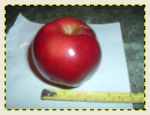 .....
.....
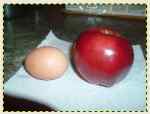 .....
.....
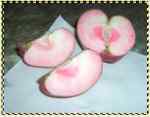 .....
.....
Blossom
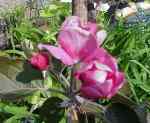 .....
.....
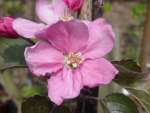 .....
.....
Immature Fruit
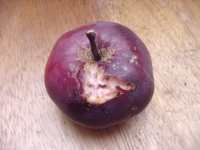 .....
.....
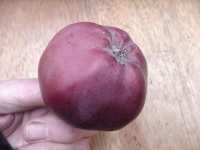 .....
.....
Note by ND....Notice the bird damage; date is still very early (9 July) ... one thing you won't find in the books is the necessity to net these trees against birds, well before they are ripe. A visit by starlings can ruin the crop in half an hour.
Mature Fruit
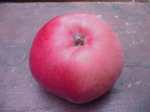 .....
.....
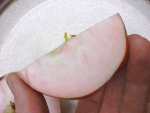 .....
.....
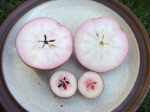 .....
.....
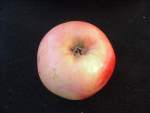 .....
.....
 .....
.....
Tasting notes
- A high quality early eating apple, ready end-Aug in 2011.
Fruit quite large; roughly the size of Bramleys, with a pink hue, a light open texture and a first-class flavour a little like Merton Knave / Hall's Pink but with hints of strawberry and peaches.
The apple does not keep more than a few days. It has a pronounced greyish 'bloom' on the skin, which can be seen on one of the photographs. The skin becomes slightly sticky when ripe, and the apple has a delicate scent.
The last picture shows Breunsdorfer and Malus Bieinrode (a much smaller redfleshed apple discovered in Bienrode, W.G. by Reinhard Schomberg-Klee).
I have not yet analysed the vitamin C content but neither apple shows much browning when cut so the levels are likely to be high; probably around 10-12 mg / 100 g fruit when in peak condition.
UPDATE Sept 2012
Fruit this year has strikingly beautiful appearance (see last photo above); pink, luminous, and pink flesh; good quality, large, low acidity; hint of strawberry and peaches. Vitamin C analysis done and was found to be 9.4 mg / 100g fruit on the single apple tested, freshly picked. Ripened mid-Sept and kept in top condition for about 3 weeks; last fruit used on 8 Oct.
UPDATE 16 Oct 2016
Late Breunsdorfers picked and eaten straight from the tree on 16 Oct came top in our apple tasting this afternoon. Beautiful delicate flavour and colour. The pink has a bluish tint to it in the best fruit.
compiled by Nigel Deacon / Diversity website